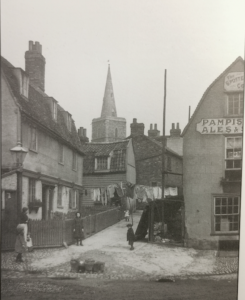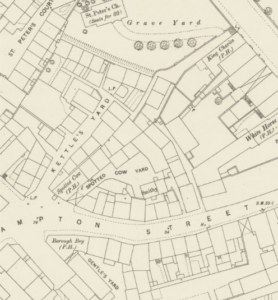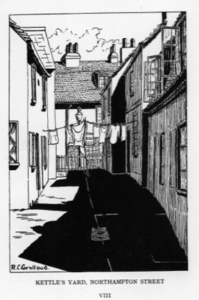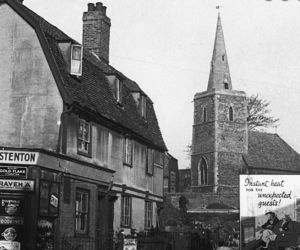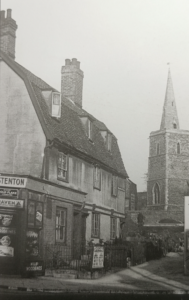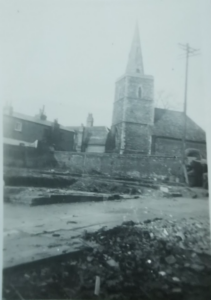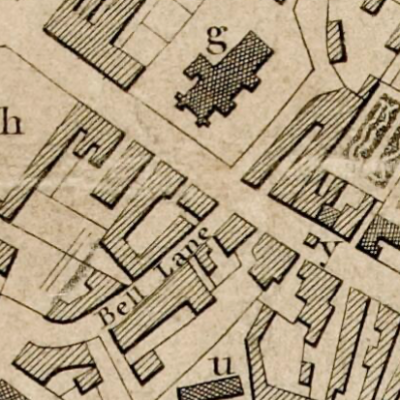Search by topic
- archaeology
- Building of Local Interest
- charity
- church
- crime
- dressmaker
- fire
- Great Eastern Railway
- Listed building
- Mapping Relief
- medieval
- oral history
- poverty
- Public House
- Rattee & Kett
- Religious House
- Roman
- scholar
- school
- Then and Now
- tudor
- women
- work
- world war one
- world war two
Search by text
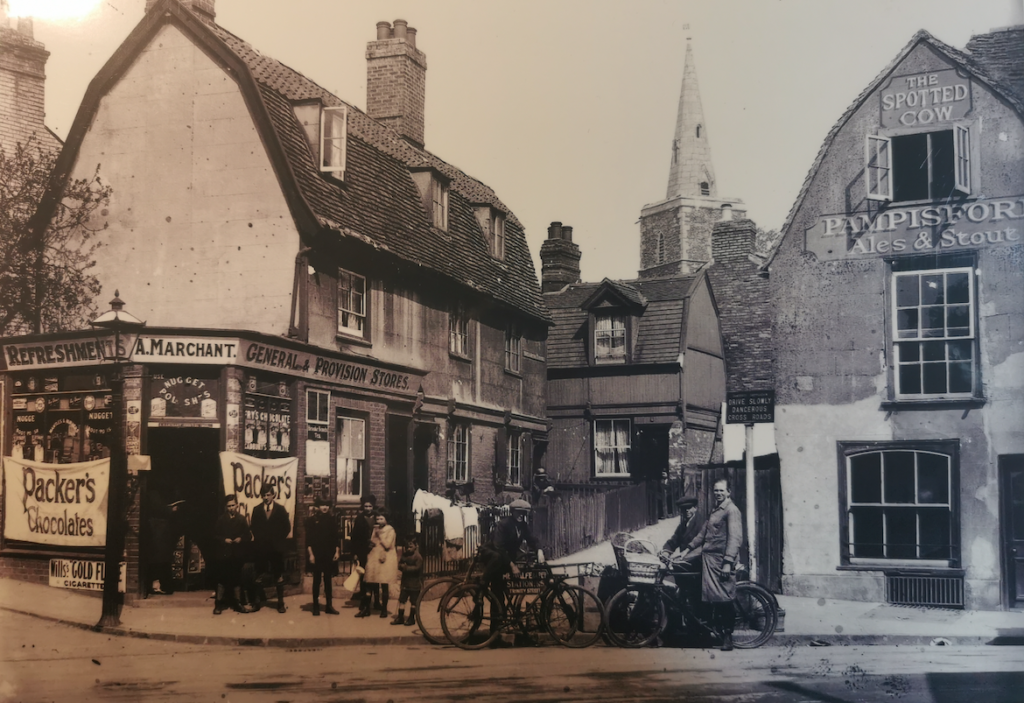 The Spotted Cow, Northampton Street and former Northampton Boot Stores and entrance to Kettle's Yard
The Spotted Cow, Northampton Street and former Northampton Boot Stores and entrance to Kettle's YardKettle’s Yard, Northampton Street
History of Kettle's Yard, Northampton Street
Kettles Yard House Guide 2002 says of the origins of Kettle’s Yard: The area of Kettle’s Yard had been a community of merchants since early medieval times. It seems to have derived its name from the Kettle family, which had been based there since the eleventh century. During the 18th century the head of the family decided to build a popular theatre on the site, but this was promptly closed by the University authorities on the grounds that it would corrupt the morals of the students. Kettle’s Yard gradually declined into one of the city’s poorest areas, a place for small businesses and jobbing tradesmen.
1765 John Kettle was a publican at the Black Bull in Impington
1861
1, Elizabeth German, 22, needlewoman, b Trumpington
2, empty
3, William Collis, 32, coal porter, b Suffolk
4, George Coulson, 27, coal porter, b Cambridge
5, James Calver, 72, carpenter, b Beccles
6, John Read, 30, labourer, b Norfolk
7, John Rogers, 56, labourer, b Cambridge
8, Edward Rogers, 70, malt???, b Cambridge
9, William Chapman, 43, brick maker, b Cambridge
10, William George, 43, shoemaker, b Cambridge
11, John Benstead, 44, bricklayer’s labourer, b Cambridge
12, Joseph Moore, 27, labourer, b Wilbraham
13. George Hall, 46, labourer, b Croxton
14, James Witt, 50, groom, b Chesterton
15, Catharine Brand, 59, b Cambridge
16, Sarah King, 53, laundress, b Grantchester
17, Ann Clark, 67, b Carlton
18, William Carter, 30, shoemaker, b Cambridge
19, James Taby, 72, labourer, b Great Wilbraham
20, James Sivell, 51, college coach driver [?], b Cambridge
21, vacant
22, James Rutter, 59, bricklayer, b Boxworth
23, Gideon Behagg, 36, college porter, b Cambridge
24, John W W Ward, 33, shoemaker, b Cambridge
25, George Thurlow, 58, shoemaker, b Cambridge
26, Godfrey Wolf, 27, labourer, b Cambridge
1871
2. Thomas Allen
3. Nathan Bowers
4.
James Charles, 61, labourer, b Histon
Elizabeth, 67, b Barton
John, 33, labourer, b Histon, imbecile
Elizabeth Gawthrop, daughter, 29, charwoman, b Histon
Elizabeth, granddaughter, 9, b Histon
Frederick, grandson, 6, b Histon
Joseph, grandson, 4, b Cambridge
Thomas, grandson, 2, b Cambridge
Ruiz, Town and Gown Prostitution, 2022, uses the example of the Gawthrop family. David Gawthrop left his wife and children in 1869. As a result his wife and children became chargeable to the ‘common fund’ of the Cambridge Poor-Law Union (Administration: Prosecution, Cambs Archives, G/C/Az29B)
5. Robert Pilsworth
6. Sarah Thompson
7. Henry Rogers
8. Edward Rogers
9. George Chapman
10. William George
11. Ann Mole
12. William Cowell
13. George Hall
14. unoccupied
15. William D George
16. John Wolfe
17. Ann Clarke
18. James Crook
19. William Collis
20. John Black
21. Richard Culledge
22. Frances Wisbey
23. Jacob Wolfe
24. John Ward
25. George Thurlow
26. John Ottaway
1881
- Robert Bright, 80, gardener’s labourer, b Middlesex
2. John Lowe, 35, coal porter, b Girton
3. James Gigney, 33, brewer’s labourer unemployed, b Cambridge
4. unoccupied
5. Martha Pilsworth, 48, laundress, b Abington
6. Sarah Thompson, 55, laundress
7. Henry Rogers, 36, brewer’s labourer out of employment, b Cambridge
8. Ann Rogers, 78, none, b Haslingfield
9. William Chapman, 62, brickmaker, b Cambridge
10. William George, 62, shoemaker, b Cambridge
11. Charles Langford, 43, general labourer, b Cambridge
12. Samuel R George, 25, bricklayer’s labourer out of work, b Cambridge
13. William A Haydock, 29, stableman, b Cambridge
14. Anne Hines, 54, washerwoman,
15. Thomas W Chapman, 28, brickmaker out of work, b Cambridge
16. John Wolfe, brickmaker’s labourer, b Cambridge
17. William H Cook, 43, bricklayer’s labourer, b Cambridge
18. James Crook, 46, groom, b Cambridge
19. Mary Collis, 52, washerwoman, b Cottenham
20. Robert Wright, 35, shoemaker, b Cambridge
21. Sarah A Levett, 35, dressmaker, b Bury St Edmunds
22. Caroline Hall, 38, college servant, b Cambridge
23. Jonas Burling, 39, fossil dig labourer, b Over
24. John Blackwell, 48, brewer’s man, b St Ives
25. Mary A Lowe, 60, laundress, b St Ives
26. Jacob Wolfe, 52, fossil dig labourer [coprolite], b Harlton
1889 Cambridge Daily News 11.2.1889: Annie Woodrough, a woman of bad character, living in Kettle’s yard, was charged by Jane Elsden [see Spinning House] of Northampton Street, with using obscene language on Friday evening. Complainant said she lived in Dullingham but was now residing in Northampton Street. She was walking in St Andrew’s Street on Friday evening. Se met the defendant about a quarter past seven near the old post office. Defendant made use of a very abusive expression and offered to fight her on the Piece for 10s. Witness was also insulted by her about ten o’clock. Florence Hire, living with the complainant in Northampton Street and who was walking with her on Friday night gave similar evidence. Woodrough denied the charge saying that she had not been out of her house until some time after the time when she was accused of having misconducted herself, and she called a witness, Annie Hammond, to prove that she had been in her house until after that time. Annie Hammond however when on her oath said that she had seen defendant in St Andrew’s Street at about seven o’clock. Mr Ekin said that this was the third time defendant had been brought up for using obscene language and the seventh time since the commencement of the year that she had been brought before the magistrate. She would be committed for fourteen days imprisonment. [See Rose and Tulip]
In ‘The Spinning House’ p125f Caroline Biggs refers to the state of Kettle’s Yard around this time. “It was a dank place where twenty-six tiny cottages squeezed into a place suitable for none. Nine years before, these homes had been described by health officials as ‘fever dens.’ Its inhabitants drew their drinking water from a pump in the churchyard of St Giles Church, where the water filtered itself through the corpses of the dead and buried.”
1913
1-2. Samuel Frost
3. Charles Garner, labourer
5. Sam Wolfe, billiard maker
6.
7. George Crook, gardener
8. William Chapman
9. James Game, chimney sweep
10. William Hammond
houses closed
17. Miss Adelaide Westley Clarke
18. Miss Mary Ann Crook
19. Mrs H Haylock
Until the early 1930s it was a rather dark and overcrowded site, characterised by cottages, workshops, pubs and shops. In the following years the area progressively turned into a slum, and as such it was ripe for clearance. When new housing for elderly residents was built on nearby Honey Hill in 1956, only four severely dilapidated cottages were spared through the efforts of the Cambridge Preservation Society. It was in this derelict state that the founder of kettle’s Yard, Jim Ede, first discovered the site in 1956.
1941
Commentary by Mike Petty in Fenland History Facebook Group: By 1941 a shop had opened but the Spotted Cow and several properties had been cleared though four small cottages at the Castle Street end considered by Cambridge Preservation Society to be capable of conversion were allowed to remain standing. They were bought by Jim Ede in 1957 and form the nucleus of the Kettle’s Yard gallery. The rest were demolished for old folk’s flats which opened in 1956 and won a Civic Trust Award. St Peter’s Church had to be underpinned in 1932 to stop it falling down. It was declared redundant in 1958 and is now cared for by The Churches Conservation Trust. As old properties were replaced by new houses the landlords demanded higher rents that the former residents could not afford, driving them out and reducing the trade of pubs and shopkeepers.
1957
Jim Ede bought the four tiny condemned slum dwellings, the remaining buildings of Kettle’s Yard.
In 1981 George Hatton (3 Albion Row) recalled the games children used to play – tops and whips, roller skating and skipping on the slop from Kettle’s Yard to Northampton Street. He remembered the sign visible in a photograph warning drivers to drive slowly as they approached the Northampton Street Castle Street crossroads.
Contribute
Do you have any information about the people or places in this article? If so, then please let us know using the Contact page or by emailing capturingcambridge@
License
This work is licensed under CC BY-NC-SA 4.0





